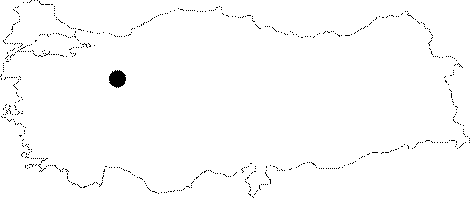| Location: It is located 7 km south of Günyüzü District, which is 135 km far from Eskisehir Province, at the center of Gümüskonak. |
| Geography and Environment: The name of the settlement where the church is located was "Germia" during the Byzantine Period. This name continues its existence as "Yürme (or Yörme) today. Germia was a city of Galata II during the Early Byzantine Period and it was regarded as pilgrimage center beginning from the early period. The most important reason that it became a pilgrimage center is the tunic fragment of Christ kept in the crypt of the church. This was mentioned in the hagiography of Saint Theodore of Sykeon. It is also mentioned that the Emperor Justinian has visited here and prayed just before he died. This information also shows the importance of Germia and Basmelek Mikhael Church (Archangel Michael Church). |
| Research and Excavation: The church was discovered by J.M. Kinneir in 1813 [Kinneir 1818:49]. After Kinneir, W.M. Ramsay has described the church and stated that the church could be a Diocese [Ramsay 1883:23]. The engraving showing the appearance of the church was presented by K. Humann [Humann-Puchstein 1890:32]. J.E. Crowfoot, on the other hand, was the first scholar who described the structure in detail and questioned its authentic architecture. In his research, Crowfoot has also published the plan of the structure and the sketch of the western façade [Crowfoot 1898:86-92]. In 1903, Strzygowski published the photos belonging to the church, which haven't been published before, taken by Crowfoot and mentioned the stone workmanship on the remains of the façade [Strzygowski 1903:115, 170-171]. After Strzygowski, Germia settlement and the church were introduced by Belke and Restle in Tabula Imperii Byzantini in 1984 [Belke-Restle 1984:166-168]. The first paper about the church was published by C. Mango in 1986 [Mango 1986:117-132]. After the survey studies conducted in Saint Mikhael Church and Germia city, the excavation project was initiated in partnership with The Istanbul Department at German Archaeological Institute, Brandenburg University and Eskisehir Archaeological Museum in 2009. The project is being conducted under the directorship of Dr. P. Niewöhner [Niewöhner-Rheidt 2010; Niewöhner 2010, 2011, 2012]. |
| Description: Building Phases: At least three building phases were defined in Basmelek Mikhael Church. The construction of the church took place in the 5th century. The written sources mentioned that Patriarch Studios decided to build the church after he was impressed by a miracle told during the council gathered in Constantinople in 454 [Mango 1986:124-125; Mitchell 1993:117]. Based on the capitals, which bear the monograms of Justinian and his wife Theodora, found around the structure belonging to the second building phase, it is dated to the mid 6th century [Strzygowski 1903:115; Mango 1986:124-125]. The third phase, on the other hand, is dated to the period after the 10th century in Middle Byzantine Period in which Germia became Diocese, due to the changes made, which is unusual in the Early Byzantine Period, in the zone of transition of the dome [Niewöhner 2011:50]. Architectural Features: Basmelek Mikhael Church is a domed basilica with five naves. The well-preserved sections of the church are the south section of the narthex, the one of the northern naves that remains inside and the additional room on the southeast corner. The structure is 50 m in length and 27 m in width excluding the towers located on both sides of the west façade. To the west, the narthex in rectangular plan in the north-south direction with five entrances locates. The vast majority of the eastern half of the narthex is preserved. Only the south section of the western part consisting of the façade has been preserved up to date. Today, only some parts of the stairwell tower, which were shown in Crowfoot's plan and sketch of the façade on the southwest corner, can be seen. The eastern half of the church and the features of the apse are not clear today. In this section, only the additional room in square plan located to the southeast corner can be seen. The support of the structure which can be seen in the northern nave inside, are in the form of pillars with square, rectangular, "L" and cross shaped sections. In the nave, these pillars placed facing one another form sections in square plan. There are neatly cut square block stones on the pillars and arches on the west of the nave. Three rows of roughly carved cut-stones and the four rows of brick which were bonded in alternate order are noteworthy. Decorative Features: In the western façade, the arched slabs, which were shown façade sketch drawn by Crowfoot, symmetrically placed on both sides of the entrance don't exist today. Some of these slabs are found at the pedestal of the minaret of Gümüskonak Merkez Mosque today. |
| Finds: A great number of architectural plastic materials, which might belong to the structure, scattered around the center of Gümüskonak. |
| Interpretation: Based on the monogram found on the capital of the impost, J.W. Crowfoot dated the first building phase to the first half of the 5th century [Crowfoot 1898:90-91]. However, his analysis is incorrect. He read the monogram as "Eudoksia" and therefore he claimed that the wife of Arcadius, Eudoksia had the church built. But Strzygowski stated that the monogram belongs to the name of Theodora [Strzygowski 1903:115]. When it was proved that the other monogram on the other side of the capital belongs to Justinian, it is seen that Strzygowski's analyze is correct [Belke-Restle 1984:168]. C. Mango stated that the church has two phases belonging to the 5th and 6th century. P. Niewöhner agreed with Mango and also stated that the church has a third phase belonging to the Middle Byzantine Period [Niewöhner 2011a:50]. |
| Destruction: |


